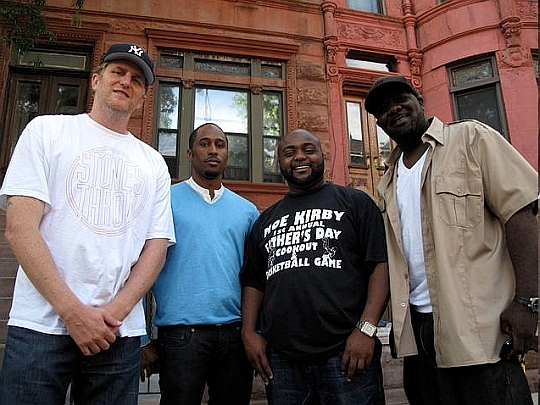Thanks to True Hollywood Story and Behind the Music, watching music-centered biopics and documentaries is often akin to watching Titanic in that you are relegated to waiting for the boat to crash into an iceberg of ego and slowly sink as the mates argue over which dinghy to take. The formula for these shows is simple: take two people who meet in a shared setting like high school, church, rehab, etc., add one surprising talent like the ability to sing, drum, play guitar, or write killer lyrics, find two other friends to be the “other guys in the group,” and sprinkle in a modicum of success (ego-yeast). Stir together and wait for one of two possibilities: one member says “I’m sick of being in your shadow. We are a band! You’re not the leader!” or the other declares “I don’t want to be held back. It’s time to venture on my own.”
Elements of this formula appear in Beats, Rhymes, and Life: The Travels of a Tribe Called Quest, but the Michael Rapaport directed documentary veers – mostly — away from the Behind the Music melodrama by making the iceberg – in this case the rift between Q-Tip and Phife Dawg — a tertiary issue. Because of his sycophancy, it’s surprising – and refreshing – that Rapaport is able to fashion a movie that avoids making the collapse the focus, particularly since the film opens with a more contemporary Q-Tip, Phife Dawg, Ali Shaheed Muhammad, and Jarobi, all of who have just performed together and all of who are in separate rooms after the show, offering variations of “Only we know if we’ll ever be on stage together again.”
After this flashforward, BRL touches on the inception of A Tribe Called Quest but handles it with brevity, expositing individual histories of the group members and how they are connected. And, this is also where the documentary differs from other variations of band-drama: the majority of the film is divided into two foci and manages to switch back and forth between the two rather seamlessly. The first is the inspirations for the music: most notably, samples from other musicians. And this is interesting to note in that financial disadvantages ultimately led to the creation of Tribe’s music. As Q-Tip narrates, “you had to use what you had,” namely splices of other performers’ music to re-interpret and create your own. In this way, the band itself is also defined as a collective – culturally, generationally, and inspirationally. Through the illustration of this collective, Rapaport manages to show us the personalities of each performer – primarily Q-Tip and Phife Dawg – as opposed to laying tracks of narration that exposit “Q-Tip was a control freak” or “Phife Dawg’s focus often lies elsewhere.”
Through various interview clips and archival performances, the audience sees the energy that drives Q-Tip to want to perform “to death” like “James Brown” and “MJ.” We are also voyeurs to a perfectionism that grows with each passing year within the film, making each track increasingly nuanced and laden with multifarious symbols and signs. Rapaport splices these clips together fluidly, interspersing clips of camaraderie and emotional honesty that renders these performers as less flat characters in a documentary and more complex, complicated, conflicted human beings.

The same care is taken with Phife Dawg, a talented lyricist whose job it is to bring “Q-Tip back from whatever planet he’s gone to,” but who has many passions like recruiting for basketball teams, promoting other groups, and being a family man to his wife and children. It’s clear from similar clips used to exposit Q-Tip’s ideology that Phife’s recognition of his own mortality impels him to foster various passions. A Type-1 diabetic, Phife’s energy is sapped with each subsequent performance, and the window that he has to satiate his passions and familial obligations grows potentially shorter and shorter as he gets older, an understanding that seems to be his motivation for moving his family away from New York to Georgia, where they can have a “better life,” an act that ultimately augurs the disconnect between him and Q-Tip.
Refreshingly, Rapaport does not villanize either side, but rather imagines Q-Tip and Phife as brothers who are having a spat. There’s a mutual love and respect between both men, but circumstance has fostered resentment that makes it difficult to be in the same room. At times, you want to shake them both because their egos ultimately get in the way, but neither can truly be brandished as the bad guy. Rather, the mutual acrimony is set by both men in a clash of perception and reality, so neither is truly “at fault,” but neither can be absolved of their actions either.
The second focus of the film is the collective force of the music and the group. While Tribe drew on various inspirations and re-imagined them in their own constructs, Tribe itself impelled and became a part of an amalgamated hip-hop scene that included the Jungle Brothers, Queen Latifah, Red Alert, and De La Sol among others that set out under the moniker The Native Tongues to break away from groups with sentiments like “Fuck the Police,” a poignant and relevant sentiment from N.W.A, but one that, as Monie Jones asserts, “has a time and place,” but doesn’t need to be perpetually ubiquitous. While rather ironic given the ultimate crumbling of Tribe in 1998, The Native Tongues collective effectively erased personal identity and success by fashioning the awareness of unity through non-divisive, Afrocentric lyrics.
Clearly, the demise of Tribe and the related animosity and tension needs to be tackled in theBeats, Rhymes, and Life, but it doesn’t need to be here because the film truly speaks more to musical inspirations, the iconic pioneering of hip-hop, and Tribe’s influence on the genre and its relationship with the fans. Let VH1 and MTV cover the melodrama – since neither appears to be in the music business any longer.



